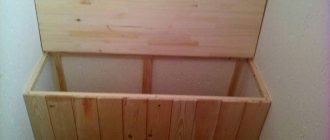Unlike owners of country houses (with a garage and basement), for residents of city apartments, organizing the storage of vegetables can become a real problem.
Too high or, conversely, low air temperature on the balcony, bright sunlight significantly reduces the shelf life of vegetable stocks.
Special boxes for storing vegetables on the balcony will help solve the problem. Diverse in design and materials of manufacture, they will forever solve the problem of how to store on the balcony a crop grown with your own hands or a supply of vegetables purchased at the market.
What are they?
A box for storing vegetables (balcony cellar, thermal storage), as they call a container, thanks to which you can preserve the harvest of root vegetables on the balcony of a city apartment. Depending on the materials of manufacture and operational characteristics, all boxes for storing vegetables are divided into two groups.
Flexible Balcony Storage
Externally, a flexible cellar is a bag sewn from several layers of thick textile impregnated with a special water-repellent compound and soft padding polyester.
The absence of clear forms solves the problem of limited balcony space. The bag fits easily under a table or bench, and when there is no need to use the cellar, it can easily be rolled up and stored in a closet.
Flexible balcony storages are equipped with a special thermostat , which allows you to maintain the required temperature for storing vegetables inside the box at any time of the year. The cost of textile boxes varies from 6,500 rubles. up to 10,000 rub.
Hard cellar (thermal cabinet)
These are steel, rather bulky boxes for storing vegetables. The outside of the cellar is covered with powder paint, protecting the metal from corrosion. The inside of the heating cabinet is lined with extruded polystyrene foam.
To maintain the necessary microclimate, ensuring high-quality storage of vegetables, the oven is equipped with a thermostat and a forced ventilation system. This feature allows the cellar to be used year-round (at temperatures from -35°C to +35°C).
The average cost of a heating cabinet is 20,000 rubles. Since a stationary thermal box for storing vegetables operates from the mains electricity , before purchasing it is important to check whether there is an outlet installed on the balcony (if not, you will have to spend money on its installation).
Assembling a vegetable thermal container
Having prepared all the necessary components, you can begin assembly. It is performed in several stages. The algorithm is like this:
- If the product is supposed to be “mobile”, then the frame of the box is assembled from bars. They can be attached to each other using metal corners.
- The bottom needs to be raised above the floor of the balcony, so two bars are attached to it, closer to the middle, which will not only provide an air cushion, but also impart rigidity to the structure.
- Insulation is being installed. It is cut to sizes that correspond to the perimeter of the planes between the beams. The insulation should be as thick as the size of the block. To ensure that there are no gaps for cold between the bars and the insulation, the resulting gaps are filled with polyurethane foam.
- Thin plywood is fixed at the bottom to cover the insulation.
- One of the pre-prepared heating devices is placed on top of it. Due to its small thickness and safety in operation, infrared film is optimal for the box.
- They also form a “warm pillow” with the help of light bulbs, but in this case the volume of the box is reduced, since an additional lattice bottom must be installed on top of them.
- After this, it would be good to line all internal planes with polyethylene foam, preferably foil-coated.
- If a light bulb is used for heating, the lattice bottom is not covered with polyethylene.
- The gap between the box frame and the lid, on the side where the hinges are supposed to be installed, should also be covered with elastic foil polyethylene foam. After installing the cover, the strip of insulation material is secured with staples to both the cover and the box.
How to do it yourself?
It’s not difficult to assemble a box for storing vegetables with your own hands. Just a little patience and available materials and the much-needed storage for vegetables on the farm is ready.
Let's look at an example of how to assemble a box for storing vegetables on an insulated balcony with your own hands:
- Determine the dimensions of the box. To do this, you need to measure the free space on the balcony, which can later be used for the container.
- We cut a wooden beam for the future frame.
We begin assembling the frame.
First of all, we assemble the base. Four vertical posts are fixed to it. All elements are connected to each other with self-tapping screws (for strength, you can additionally use metal corners).- We assemble the base of the lid from the beams.
- We lay a layer of foam plastic on the bottom of the box, after which we cover the body with a board. An important point: in order to maintain the required level of humidity in the box, the boards must be filled with a gap of 1-2 cm.
- The lid is sheathed with a board and attached on hinges to the body of the box.
After the vegetable storage chest is assembled, it must be coated with water-based varnish. This will not only protect the wood from rotting, but will also give it a pleasant shine.
If the balcony is cold and the air temperature in winter drops below +5°C, the box must be insulated. For this:
- The inside of the container is lined with foam plastic (the thicker the layer, the better). The bottom and lid must be insulated.
- An internal storage container is inserted into the insulated box. To do this, measurements are made of the free internal space of the box, according to which another box is assembled from wooden beams and chipboard sheets. An important point: holes for ventilation must be drilled in the walls of the inner container.
- Place the box for storing vegetables in an insulated box. The box is ready!
If desired, according to the size of the box lid, you can sew a soft seat (foam rubber covered with fabric). The seat will not only serve as additional insulation for the vegetable storage, but will also turn the box into an additional place to relax.
The video will show you how to make a box for storing vegetables on the balcony:
Vertical drawer design
Option for vertical implementation of the box.
An excellent option is to arrange a vertical vegetable storage facility with your own hands on the balcony. Thanks to this option, you can save a lot of space in the room and place a lot of vegetables in the structure. This cabinet has its own characteristics:
- The heating lamp, in contrast to the design described above, is located at the bottom.
- Since the door to the balcony storage opens to the full height of the cabinet, access to the heating element is unobstructed.
- The vertical arrangement will eliminate the need to use a fan.
- To make the heating process more efficient, one lamp is placed at the very bottom, and the second at the level of the middle of the cabinet.
Even at the planning stage, the design should be calculated in such a way that the home vegetable storage facility has a reserve to withstand operational loads. It is better to make shelves from boards, and then install them so that all the boxes can rest on them with their edges, while there should be some gap in the middle. This will significantly facilitate air circulation, and the temperature, even without a device such as a thermostat, will be optimal.
However, in this case you will still need insulation. To do this, the shelves are moved a certain distance from each wall exactly by the thickness of the foam. To prevent accidental opening of the cabinet doors, bolts are installed on them - one at the top and the second at the bottom.
How to choose?
Among the wide range of boxes for storing vegetables, it is quite difficult to choose the most suitable option for yourself.
To avoid mistakes, you need to determine several points before purchasing:
- the dimensions of the box (an important decision-making factor is the availability of free space on the balcony);
- material of manufacture (the quality and safety of wood, metal or plastic must be confirmed by appropriate certificates);
- the presence of ventilation and thermal insulation (necessary conditions for high-quality storage of vegetables).
Flexible cellars and wooden boxes without heating are a good option for insulated balconies. If the air temperature on the balcony in winter drops below +5°C, you cannot do without a heated thermobox.
What is a vegetable storage on the balcony
The simplest design that can act as a vegetable storage on the balcony is a simple box . Structurally, it is a thermos, since it has two parts - external and internal. A layer of insulation is installed between them.
On a note! In order for the box to become reliable storage on the balcony, it is necessary to install a fan to circulate air masses, as well as a small heating unit. The automatic system works in a simple way - when the relay is turned on, the heating of the box starts.
You can make such a mini-warehouse from wooden boards 0.5 cm thick . the box is sheathed with 0.1 mm plywood sheets, the foam for insulation is standard in size, but this parameter is taken into account at the design stage.
Note! If you choose too thick a layer of thermal insulation, this will take away important centimeters of internal volume and reduce capacity.
With sufficient heating and ventilation, the insulation can be quite thin . To ensure the required humidity inside the storage facility, a proper ventilation system with an adjustable damper must be provided. During storage, vegetables breathe, emitting gas (ethylene, for example), and in winter the air is too dry, which leads to food spoilage and drying out of fruits.
According to statistics, for regions with low temperatures in winter, 10 cm of foam thickness is selected, and for mild climates in the southern regions, 0.4 cm is sufficient.
TOP 3 best models
You can buy a box for storing vegetables on the balcony in the online store. It is enough to type “cellar” or “thermal box” in the search bar and the system will display a fairly extensive list of sites and stores selling similar goods. Among the variety of thermal storage facilities, the following models deserve special attention:
Balcony heating cabinet EDS Cellar 95 l
A flexible container made of three-layer textile material impregnated with a special water-repellent composition. The outer layer is padding polyester. A flexible wire heater maintains the required temperature for storing vegetables inside a soft container.
In order to set the necessary parameters, you need to press the button on the panel. After this, the bag is loaded with vegetables, carefully sorted into mesh bags (included). If necessary, the flexible balcony storage unit can be fixed to the wall (the kit includes two dowels and screws).
The average cost of a thermal cellar is 6,500 rubles.
Year-round cellar Predictor 180 l
Regardless of external conditions, it maintains the optimal storage temperature inside the box from +2°C to +10°C. Can operate in both heating and cooling modes .
The metal body is covered with a wear-resistant polymer that protects the cellar from mechanical damage. A spacious (180 l) container helps preserve healthy and tasty vegetables throughout the winter. The average cost is 40,500 rubles.
Thermal cabinet "Winter cellar"
Maximum volume (360 l) heated chest . The digital panel simplifies the process of setting the desired temperature inside the box as much as possible. Just press the button and look at the specified parameter on the display.
The heating cabinet can be operated at extremely low temperatures (down to -35°C). To operate the heating element, one 220V socket is enough (electricity consumption is only 225 W).
Using the oven is very simple : just load the nets with vegetables into the cabinet, close the door tightly, and use the buttons on the control panel to set the desired temperature. The average cost is 25,000 rubles.
The principle of operation of the cellar thermostat
For general information, you need to understand that the thermostat in everyday life is used in different devices: from a refrigerator to an iron and a soldering iron. The process of operation of the thermostat itself is very simple, the setup of the work is primitive, and as a conclusion there is a simple electrical circuit.
The most complex and time-consuming process in creating “simple” thermostats is bringing them to the required temperature.
To determine the characteristics of the temperature points on the scale, you must first immerse the sensor with ice that melts (this is approximately zero degrees Celsius), and then sharply into boiling water (this is 100 degrees).
After this check, you need to adjust the required temperature so that the trial and error method using a voltmeter and thermometer works.
Video:
Nowadays, different factories produce many temperature sensors, which are already correctly calibrated at the time of their creation.
These are sensors that are found in microcontrollers. The output information of these sensors is digital; it can be transmitted via a bidirectional single- wire 1-wire , which facilitates the creation of an entire network based on similar devices.
In other words, it is very easy to create such thermometers and also control the temperature (for example, on the balcony and outside the window, and even in different rooms).
When is additional heating needed?
When installing a vegetable box on a cold (uninsulated) balcony, where the air temperature in winter drops below -5 °C, it would be a good idea to take care of additional heating of the container. As an option, you can use film heated floors.
Algorithm of actions:
- Cut out a piece of film flooring in places specially marked by the manufacturer, identical in size to the bottom of the storage box.
- Place a film covering on the bottom of the box, connect it to the thermostat built into the outside of the box.
- Connect the heated floor to the network.
Installing a heated floor will not raise any questions if you carefully read the film coating manufacturer’s instructions before starting work.
Closed cabinets
The most common option for storing supplies is closed cabinets.
Design options for closed cabinets:
- A closed double-leaf vertical cabinet near one of the walls - if possible, order a closed cabinet made to individual sizes made of wood or chipboard. A plasterboard cabinet with a metal profile is also not bad. But it loses to wooden cabinets in terms of load-bearing capacity. Such furniture looks aesthetically pleasing and does not take up much space, as it seems at first glance. The main thing is to calculate the depth and height of the storage shelves.
- Drawers are closed - you can cover the drawers with a board on top or place them under a bench, lay a mattress or place pillows - you will get a great place to relax. It is better to place such boxes on a rail system. A low chest of drawers with deep drawers will also fit into the interior.
- Built-in cabinet - inside there are shelves according to the size of the cans, outside there are stylish doors on a roller or rail mechanism. The only drawback of this design is that it cannot be rearranged.
- Hinged lockers along the perimeter of the balcony are a budget analogue of built-in lockers on a rail mechanism. The tabletop on top can be used as a place to grow seedlings or flowers.
What vegetables can be stored?
Provided the required air temperature is maintained, vegetables such as:
- beet,
- cabbage,
- onion,
- garlic,
- carrot,
- potato.
| The product's name | Storage temperature |
| potato | from +2 to +3 0С |
| carrots, beets, turnips | from 0 to +2 0С |
| garlic | from -1 to +3 0С |
| onion | from 0 to +1 0С |
| cabbage | from -1 to +2 0С |
Vegetables are stored in a well-shaded, ventilated, cool place (special boxes fully meet all the requirements for proper storage).
Cucumbers, tomatoes, zucchini are vegetables that cannot be stored on the balcony for a long time. For the winter, cucumbers and tomatoes are fermented or pickled. Zucchini retains its nutritional properties perfectly when frozen.
Crop compatibility during storage
Creating the right conditions means not only setting the right temperature on the balcony and preparing good boxes, but also arranging fruits and vegetables according to their compatibility.
Reference. Many fruits, from prolonged contact with others, can absorb odors, become infected with bacteria, ripen faster and rot.
It is important to take into account such nuances:
- Potatoes tend to release moisture, causing storage boxes to fog up. This can be avoided by placing beets on top of the potato layer. It will absorb excess moisture and both root vegetables will be preserved better.
- Carrots have a rather thin skin, and therefore contact of this root vegetable with each other and other vegetables should be avoided.
- Fruits should never be stored mixed with vegetables (for example, apples and cabbage), as this will lead to the formation of unpleasant odors and rot.
- Despite their similarity, it is better to store garlic and onions in separate containers. Garlic requires more moisture than onions.
- A special place should be given to citrus fruits.
Note! When storing fruits and vegetables for a long time, you need to periodically sort through them and set aside those that have begun to spoil. These foods should be consumed first - this will help avoid bacterial contamination of all other fruits.
Adviсe
Only dry, sorted vegetables, without signs of rot, are placed in boxes. Supplies are checked periodically to remove spoiled products .
Otherwise, regardless of the storage temperature, the entire crop of root crops will be spoiled.
An old, non-working refrigerator is a good alternative to store-bought vegetable storage boxes. Before use, the refrigerator is well ventilated and then placed on the floor with the door facing up.
The sorted vegetables are placed in the refrigerator (the shelves are used as partitions), covered with a clean cloth, and then the door of the improvised storage is closed.
Preparatory stage
Before you start work, you need to decide what materials the cellar will be made of. Then stock up on the materials themselves and suitable tools. For the frame, boards, chipboards, plastic panels, aluminum or steel profiles are suitable. Any thermal insulation material can be used as insulation - mineral wool, polystyrene foam, batting, padding polyester.
To properly make a cellar with your own hands, you need to imagine the overall design. This is a container of any shape with double walls, between which there is a layer of heat-insulating material. Its height, width and depth must be determined based on the free space on the balcony and the volume of products that will be stored there. But the total wall thickness should be at least 50 mm. The lid can be made removable or hinged. If it is folding, then you need to prepare the hinges.
Advice
If the walls of the frame are made of plastic panels or thin plywood, then it is better to choose slab insulation - polystyrene foam or basalt mineral wool - as insulation. It will give additional rigidity.
Is it possible to store potatoes in plastic boxes? Storing potatoes at home
In a city apartment, you can store potatoes on a balcony or loggia. For containers, use sealed boxes with a double bottom and walls. To protect against freezing on a cold balcony, insulate the inside of the container with polystyrene foam. Cover the top of the box with a lid or a dark, warm cloth to protect the tubers from light.
To avoid rotting and sprouting of produce, place rowan or mint leaves on top of the potatoes. Such plants not only help maintain optimal humidity, but also destroy pathogenic microorganisms due to the released phytoncides.
The following will also help against rotting tubers: onion peel, dried herb, wormwood, fern, elderberry leaves.
You can transfer the tubers with pine paws or store the potatoes in boxes made from fresh spruce or pine boards.
It is very useful to keep potatoes and ginger root nearby (both keep better).
If you want to store a large amount of crops on the balcony in winter, prepare a special chest where the optimum temperature and humidity will be maintained. How to do it correctly, look at
You should store potatoes at home in the summer in the pantry or under the kitchen sink. To do this, place the vegetables in a wicker basket, plastic box or perforated bucket. The shelf life of potatoes in such conditions is 14 days.
There is an opinion that you should not use plastic bags or polypropylene bags for storing potatoes (they do not allow air to pass through, which leads to rapid rotting and spoilage of the product). But if the potatoes are prepared for storage according to all the rules, then the average number of tubers (up to 20 kg) can be kept for 3-4 weeks at room temperature in a plastic bag. Conditions: the bag must be thick, dark and very well tied (for example, garbage bags). The main thing is not to open the package “in between” and not to disturb it at all.
In a city apartment, you can store potatoes under the sink in a wicker basket, wooden or plastic box. You can also organize storage on a balcony, loggia or in the entrance corridor
Storing potatoes in the refrigerator
Many housewives are concerned about the question: is it possible to store potatoes in the refrigerator? The refrigerator maintains optimal temperature and humidity, making it suitable for storing potatoes. However, remember the significant drawback of this method - limited space does not allow you to save much harvest.
To store potatoes in the refrigerator, place the potatoes in a paper bag and place it in the crisper drawer. In such conditions it can persist for up to several months. The refrigerator is ideal for storing finished potatoes - boiled, baked in jackets or stewed. This allows you to make preparations for the morning or for several days.
Sometimes housewives need to preserve peeled potatoes. To do this, place the tubers in a container and fill with cool water. You can store peeled potatoes at room temperature for 2-4 hours, and in the refrigerator for 2 days.
How to store potatoes in the freezer
Potatoes are perhaps the only vegetable that is not recommended to be frozen raw. Under the influence of low temperatures, starch turns into sugar, which affects the taste of the product.
However, you can store a small amount of blanched vegetable in the freezer. To do this, you need to prepare it correctly:
- Wash and peel the tubers well.
- Cut the potatoes into strips 1-1.5 cm thick.
- Place the raw materials in a colander and rinse with water to remove starch.
- Place the potatoes in boiling water for 3 minutes and then in ice water.
- Dry the workpiece with a paper towel and place portions in freezer bags.
- Place the potatoes in the freezer. In this form, the vegetable can be stored for as long as possible.
Before freezing, be sure to wash, peel and blanch the potatoes. Do not put raw potatoes in the freezer - they will lose their basic taste.
You can also store already cooked potatoes in the freezer: boiled mashed potatoes, fried baked slices. Prepare the potatoes using your favorite method, cool and place in plastic containers or freezer bags. Put the products in the freezer, and you will always have a ready-made preparation for lunch or dinner at hand.
Preparation and insulation
You need to start checking the insulation of the loggia from the floor - a vegetable box on the loggia, installed on a cold stove, will freeze very much from below. If the slab is severely damaged, there are areas with exposed reinforcement and chipped concrete, it is worth re-laying the leveling cement screed.
We recommend looking at how to insulate a future vegetable storage facility.
A more reliable base for vegetable boxes can be heated floors laid on joists. When insulating balcony structures, the choice of window fillings is of great importance. Double glazing of balcony windows will help to better retain heat, therefore reducing the risk of spoilage of vegetables from frost.
YouTube Premium
Do you want to save this video?
- Complain
Report a video?
Liked?
Did not like?
To store the harvest in winter, Pavel Dmitrievich made a heating cabinet with his own hands, which he placed on the balcony. This homemade “cellar” is capable of maintaining the temperature required for food even in frosty conditions. Let us consider in detail the device of this invention. Forum thread: https://www.forumhouse.ru/threads/365.
FORUMHOUSE is the most popular and authoritative portal in Russia dedicated to construction and country life. www.forumhouse.ru
More than 250,000 people have already subscribed to our channel: https://www.youtube.com/subscription_c.
FORUMHOUSE is hundreds of thousands of topics on the forum, thousands of articles and hundreds of videos on various topics covering all areas of construction and life outside the city. Here you can learn about a variety of construction technologies, find calculations and estimates, select the necessary engineering solutions and ideas for arranging your garden. Design, landscape design and even farming - on all these topics you can learn both the authoritative opinion of professionals and gain experience from ordinary people who have already gone through what is yet to come.











